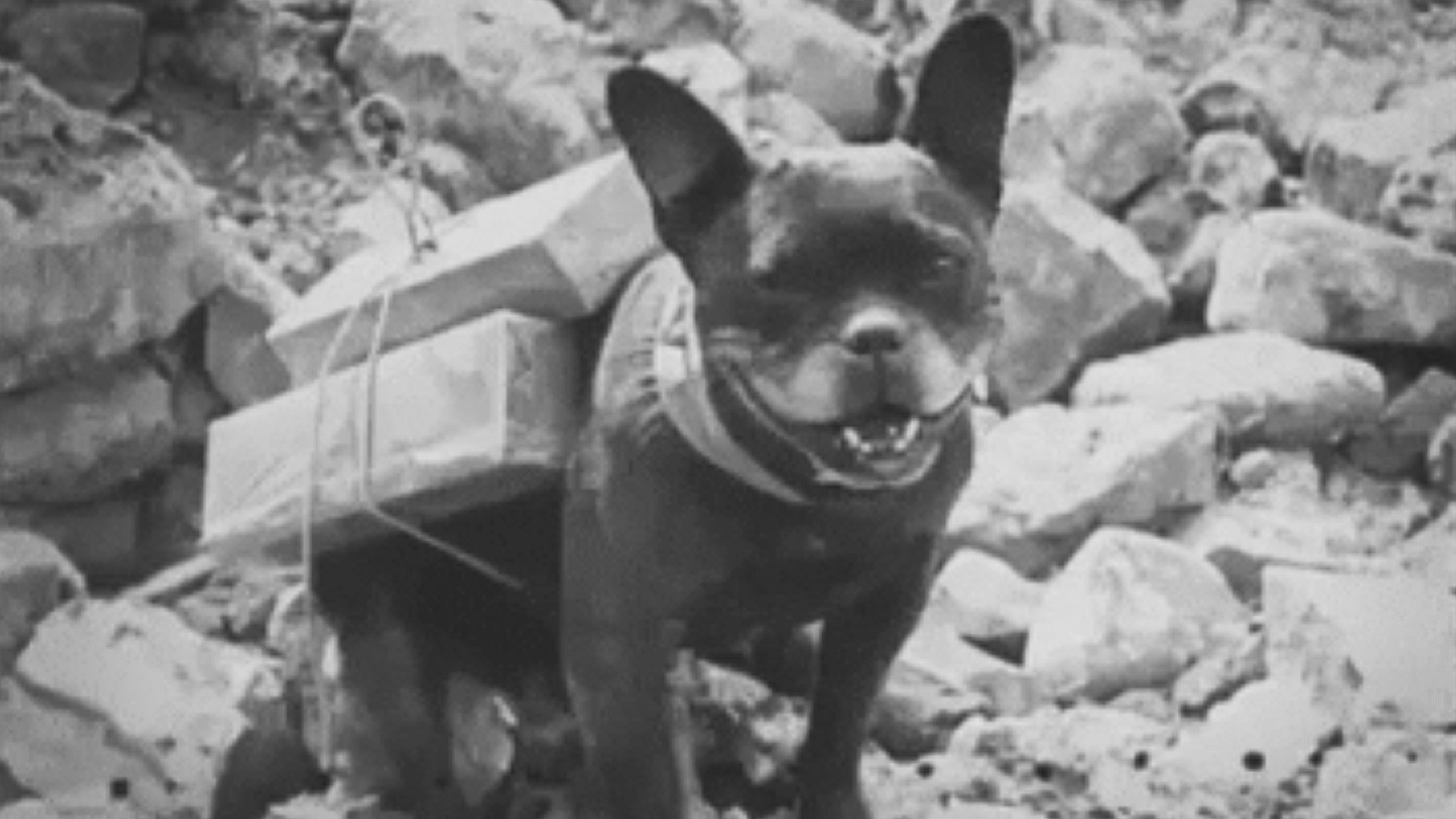

Have you ever gotten exactly what you wanted? It’s hard to imagine that any PlayStation 5 on Christmas morning could beat a pack of cigarettes showing up when you’re stuck in the trenches, but add to it that it’s delivered by an adorable dog. That’s what the soldiers of the 11th Engineers were treated to when Mutt, a YMCA trench runner loaded with ciggies, visited them in 1918 in the Aisne-Marne operation during World War I.
More importantly, the National Archives has footage (reel 1, 8:20) of this very, very good boy.
Mutt knew the uniform of the day and wore it with pride, as the photos clearly show his jaunty cravat proudly displaying the YMCA logo. And while it’s mission first, he takes time to get some well-earned trench scritches while the doughboys pass out a carton of cigarettes, no doubt providing a morale boost.
If it seems odd that the Young Men’s Christian Association was running smokes to the troops in 1918, it’s fair to say that just a few years prior, the YMCA would have thought the same. In fact, at the start of World War I, cigarettes were considered immoral, and trashy, if not necessarily unhealthy. Pipe smoking was the preferred method of nicotine hit for the refined set. However, the multi-step process of preparing a pipe required time and equipment that were not ideal during combat.
In many ways, World War I was the first American war where morale was taken seriously. The old guard disliked the “molly-coddling,” and “pink tea parties” and left relief work to civilians. The YMCA was the largest, which provided 90% of aid work through uniformed combat civilians, ranging from essential services like feeding and nursing the troops to hosting singalongs, passing out baseball gear, and soon, delivering cigarettes.
There were no smoke pits in World War I, or more accurately, everything was a smoke pit. Tobacco addressed a number of needs. It alleviated boredom and gave a psychological lift, much as it is used now, but also more dire concerns. The buzz was thought to steady the hands and create wakefulness and alertness. The smell helped to cover the grotesque stench of war: human waste, decaying bodies, and intense body odor. And, dulling taste buds were an advantage when rations were repetitive and boring and best and rancid or molding at worst. As a top staff aide to General Pershing described it, “A cigarette may make the difference between a hero and a shirker.”
We don’t know as much as we’d like to about Mutt, but one account says that he made it to America after the war. By the war’s end, when this video was taken, we know that even though the U.S. Army was issuing cigarettes, the YMCA was innovating how they conducted their operations. The same film clip shows a “Y man” selling cigarettes out of the back of a truck, quickly donning a gas mask due to an attack, then continuing with God’s work of getting the boys smokes.

A cigarette dog must have been a bit of fun, but Mutt was by far not the only dog with a job in World War I and wouldn’t have seemed that wildly out of place. Other trench runners ran messages. Larger dogs pulled machine guns and terriers were known for their excellent pest control abilities. Dogs were even taken as prisoners of war. Others served as mascots, like Sgt. Stubby, a job title that doesn’t really capture how he participated in 17 battles on the Western Front, bit a German soldier in the butt, and once saved his regiment from a gas attack. After the war, Stubby served as the Georgetown Hoya and even inspired a movie. Feel free to tell your own dog about this, because they need role models and most could honestly be helping out more around the house.
As for the YMCA, their efforts to get the troops what they wanted eventually led to a run on cigarettes, price competition, and a reputation as “those damn Y men” who charged too much for cigarettes as multiple aid and military organizations competed for a limited tobacco supply. Coming into World War II, President Franklin Delano Roosevelt asked them to merge into a group called the United Service Organizations, or USO, which, sadly, has not continued the cigarette dog tradition.
+++
Miranda Summers Lowe is a curator of modern military history at the National Museum of American History, Smithsonian Institution, and an officer in the Army National Guard. Her publications include contributions to Modern Warfare in an Ancient Land, The U.S. Army and the COVID-19 Pandemic, Why We Write: Craft Essays on Writing War and articles for The New York Times, Military Review, and War on the Rocks. Follow her on Twitter at @msummerslowe
What’s hot on Task & Purpose
- A Marine sued the Navy over how it handles ‘bad paper’ discharges and won
- Army 3-star general suspended amid investigation into toxic climate and racist comments
- The best gear under $25 to make life in the field suck less, according to soldiers
- How a rivalry between two WWII vets led to the world’s smallest flyable airplanes
- Air Force Reserve major helps to subdue unruly passenger aboard American Airlines flight
Want to write for Task & Purpose? Click here. Or check out the latest stories on our homepage.
